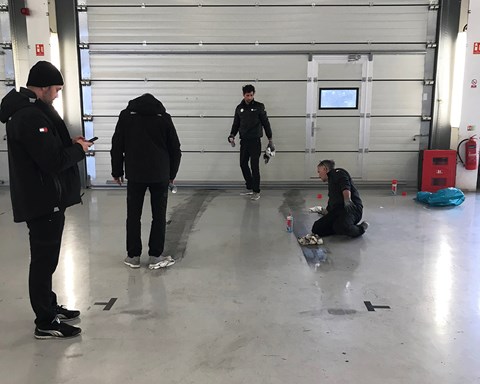► Mercedes-Benz marks 125 years in racing
► Legendary cars and drivers assemble at Silverstone
► CAR hitches a ride in some of Merc’s greatest hits
‘Hey Toto!’ Lewis Hamilton calls across the garage to his F1 team boss, Toto Wolff, motioning to two achingly cool 190 DTM touring cars. ‘Let’s go and drive together – you take that one, I’ll take this one!’
It’s the day before a big Mercedes birthday party. The company is celebrating 125 years’ involvement in motorsport by bringing together a spectacular array of cars from its racing history at Silverstone. Tomorrow the festivities begin in earnest but right now it has the circuit to itself for prepping and filming; CAR is a fly on the wall.
The dual 190 drive (main image) is a genuinely impromptu moment that sends Mercedes’ media team scrambling for GoPros and cameras to capture it for their social channels as Hamilton and Wolff clamber into the touring cars. Moments later they’re hammering past the pits at full tilt, swapping positions every lap, at play for the fun of it.
‘Lewis’s car is about 100 horsepower down,’ a team onlooker says to a colleague; ‘that’s probably a fair handicap, 20bhp per world title…’ They return to the pitlane, grinning and twirling imaginary steering wheels as they compare notes. ‘That’s the most fun I’ve had in a long time’ Lewis beams. It’s a special moment ahead of a day that will be packed with them.
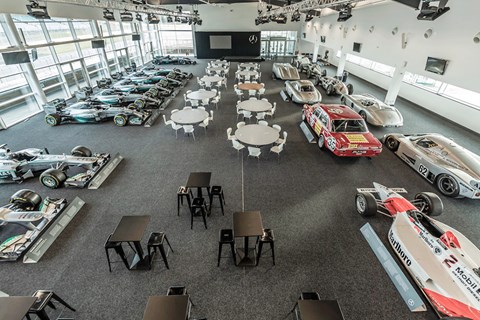
Wind forward a day and the birthday party is in full swing. The breadth of machinery Mercedes has amassed from its ‘Holy Halls’ collection is quite something.
From the 1909 ‘Blitzen Benz’ – 21.5 litres, chain drive, and one heck of a noise – to F1 cars from each of the company’s 10 seasons as a modern-day constructor (it’s easy to forget Mercedes has now been racing as a Formula 1 team in its own right for an entire decade), and everything in between: a beautiful 300 SLR, of the type in which Stirling Moss and Dennis Jenkinson won the Mille Miglia; the Le Mans-winning Sauber-Mercedes C9 Group C car; a bare-metal-bodied 1934 W25 Grand Prix car, according to legend the very first ‘Silver Arrow’, the result of the mechanics sanding off its original thick white paint to reach the minimum 750kg weight limit before its first race; and the stunning 1000bhp+ 1994 Penske-Mercedes IndyCar, to name just a handful of the racing cars assembled in the Silverstone Wing.
Seeing one of these cars on its own would be a big deal; seeing them all together at the same time is fairly mind-blowing, not least because many of them are being demonstrated at full-tilt on track by a host of driving heroes.
The 125-year-old kick-off date might seem tenuous; a V-twin engine designed by Gottlieb Daimler and Wilhelm Maybach powered the winning cars in the very first ‘horseless carriage’ races in France in the 1890s (albeit manufactured under licence by French outfit Panhard & Levassor), hence the century-and-a-quarter anniversary.
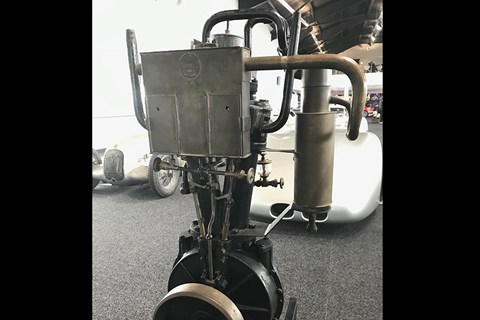
By the early 1900s, Daimler Motoren Gesellschaft’s cars had grown another two cylinders, and already started using the Mercedes name. We clamber aboard the 1904 Mercedes Simplex – so called because it was comparatively simple to operate by the standards of the day. But it looks anything but. The driver has five pedals to operate (two of them for the brakes) and changing gear is a deliberate, complex operation. And yet winds it up to quite a pace around Silverstone’s Stowe circuit, passengers hanging on and grinning, while Valtteri Bottas blasts past on the straight in a 1950s 300 SL Gullwing. It’s that kind of day.
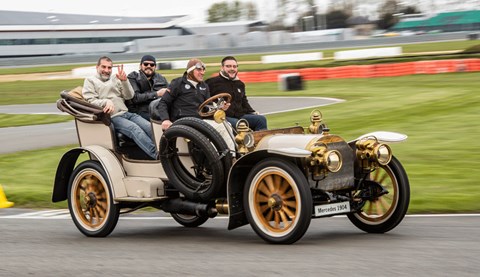
From the Simplex into a brutal-looking 450 SLC rally car, driven by reigning DTM champ Gary Paffett. Designed for monster events like the 40-day, 186,000-mile South American rally, it has a raised ride height, rumbling V8 engine and, in Paffett’s hands, balletic oversteer.
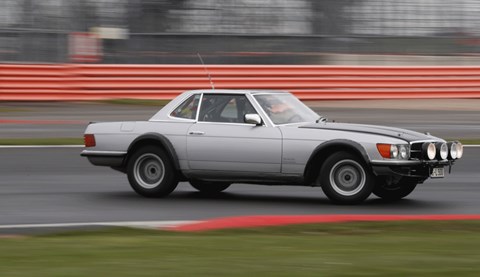
Into another classic rally car; F1 safety car driver Bernd Maylander temporarily swaps his modern AMG GT for an elegant Pagoda-roofed 230 SL, the same car that won the 1963 Spa-Sofia-Liège rally, guiding the Pagoda with small, deft, deliberate steering inputs around Stowe.
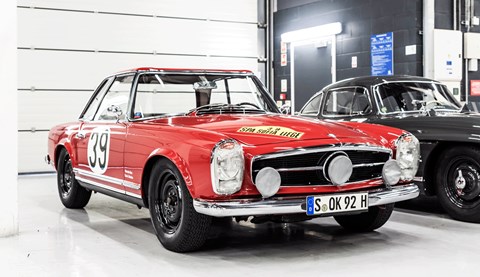
And then we’re onto the main Silverstone International circuit in something altogether quicker; climbing through the thick-tubed rollcage into the passenger seat of the AMG GT3 that’s currently competing at the forefront of international GT racing around the world. This time it’s ex-F1 driver Karl Wendlinger at the wheel, and he’s the smoothest driver of the day, his steering and brake inputs like those of a limo driver despite the extreme cornering speeds of this high-downforce, high-grip machine.
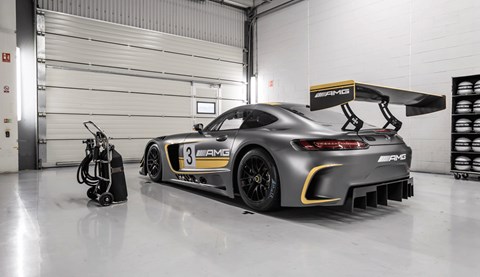
By contrast, ex-DTM driver Kurt Thiim (father of current GT racing star Nicki) is more aggressive, driving another AMG GT but in GT4 spec– more closely related to the road car, with narrower track, less power and downforce and more basic suspension), attacking the corners and hustling the steering to feel the grip. Both styles are great fun to experience, and both cars as exciting to ride in as they are to look at.
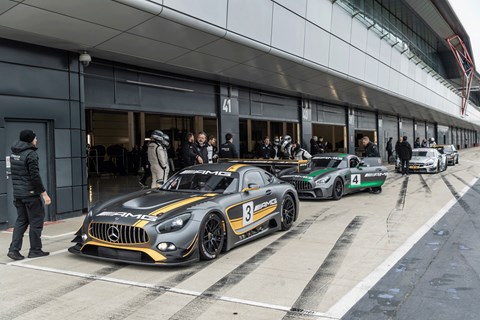
And then it’s into the very same car that Lewis Hamilton was driving the day before – the 190 DTM, with ‘Mr. DTM’ Bernd Schneider at the wheel, the most successful driver in the championship’s history. It’s a surprisingly civilised interior, still with the road car’s door card trim and, amusingly, ‘economy’ gauge on the instrument panel – on Schneider’s flying lap it’s always in the red.
‘It’s not the fastest car in a straight line, but the handling is good,’ Schneider says. The speed he carries into corners is quite something, and at the quick Stowe corner he trail-brakes while rev-matching downshifts through the H-pattern gearshift all the way to the apex. It’s hard to imagine anyone getting this car around the circuit quicker. It’s no wonder F1 star Mark Webber described Schneider in his autobiography as the driver he learned the most from on his journey to F1 when they were team-mates racing the monster CLK GTR (another car on display today) in the FIA GT championship.
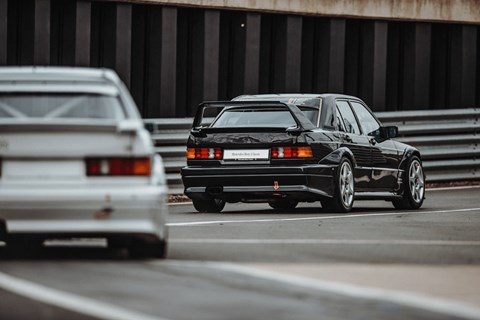
We finish with the most intense ride of the lot, with Gary Paffett back behind the wheel, this time in a modern-day DTM car, the so-called ‘race taxi’ used to give flying lap rides to guests at intervals in championship rounds. This particular car’s a 2012 chassis with 2017 bodywork, the mechanics tell me, as they remove the passenger door – the only way to access the car is to remove its composite door entirely, and then place a heat-proof right-angled carbon panel over the box sill, through which the hot exhaust exits. Sit on the sill, swivel your feet in, grasp the rollcage and lower yourself into the passenger seat. It’s not pretty in here: all matt-black crossmember bars and box-section carbonfibre. Compared with the 190 DTM, it no longer resembles a road car at all, more a military jet.
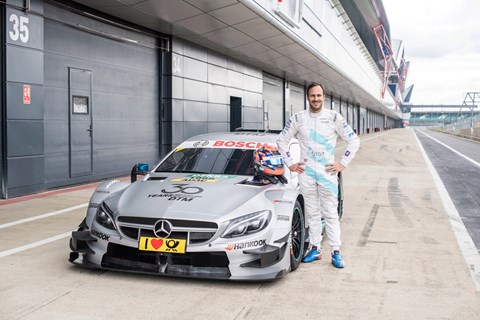
You sit in a reclined position, and so far back you’re practically where the rear seats would be in a road car.
Paffett lights it up and exits the garage on opposite lock*. The high-revving V8 engine (no longer a part of the DTM scene, as the championship moves to four-cylinder turbos for 2019) is resonant, buzzing uncomfortably through the chassis. It’s a visceral, almost violent experience; downshifts bang through the drivetrain and the mirrors, such as they are, tiny reflective slivers of plastic, vibrate crazily, much like everything else in the car.
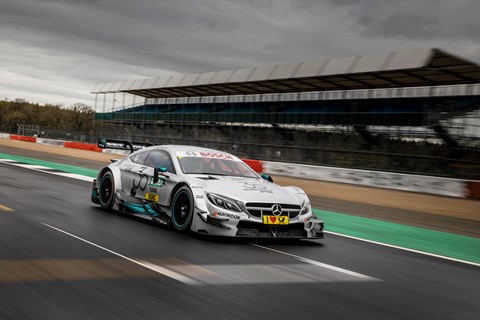
More’s the pity Mercedes is no longer a part of the DTM – but Paffett has joined the marque’s newly formed Formula E team, the electric single seater looking tiny but elegant on display next to the longer, wider more aggressive looking F1 racers. ‘It’s a really challenging formula to drive, but a very rewarding one,’ he says.

Surely one of the most beautiful F1 cars ever is here too, the W196 Streamliner, as raced to glory by Fangio and Moss. In the Silverstone pitlane it looks stunning, more sculpture than racing car. Usually an open-wheel car, it only wore the low-drag streamlined body four times in period, at faster circuits such as Reims, Monza, and Silverstone – so it’s kind of coming home. Yesterday Hamilton and Wolff both took a turn behind its big wood-framed wheel, both of them leaving their crash helmets behind for the full wind in the hair experience.
One of the original Silver Arrow drivers is here too, Hans Herrmann. Team-mate to Fangio and Moss in the 1950s (and winner of Le Mans in 1970 in a Porsche 917), Hermann is now 91 years old but looks decades younger. His nickname, Bernd Schneider tells CAR, is ‘Lucky Hans’ – Google ‘Hans Herrmann Avus accident’ to see why.
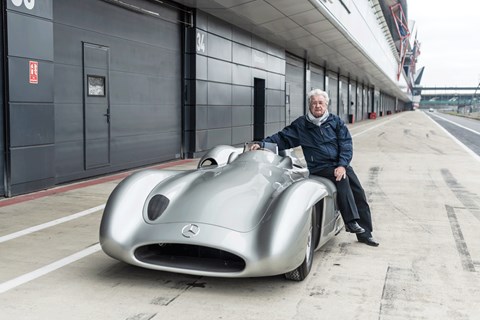
The rides are over, the cars are being packed away, F1 cars painstakingly squeezed through the Wing’s doors and onto lorries, but we want to stay, to be around the remaining cars for just a bit longer. We’re rewarded by one more treat: Valtteri Bottas climbs aboard a W125 from the 1930s, one of the most fearsome Grand Prix cars of all time, with as much as 600bhp on tap in period and recording speeds of as much as 190mph.
A mechanic inserts a starter into the nose and the supercharged straight-eight fires up, a gruff, ear-shattering blast echoing off the pit garages. The sound intensifies as he pulls away and traces him around the circuit as he disappears from view, rising as he hits Hangar Straight and, sooner than we expect, crescendos as he comes into view onto the pit straight.
He’s not hanging about, blatting past the pitwall and braking intrepidly late for the first corner considering he’s in a car with drum stoppers and a practically priceless value. A lap later he enters the same corner with a decent turn of opposite lock dialled in. Respect.

He returns and is immediately mobbed by cameras and handed a smartphone to record a video for Merc’s social media channels. It’s an odd tableau of 1930s and 21st century tech merging that somehow sums up the day.
If cars as we know them are still around in another 125 years’ time, and people are still allowed to drive them, they will still want to race them. You get the feeling there’ll still be cars with three-pointed stars on their front racing in another century and a quarter’s time – and, if so, they’ll likely be at the forefront of the grid.
*Here’s the clean-up operation at the end of the day:
